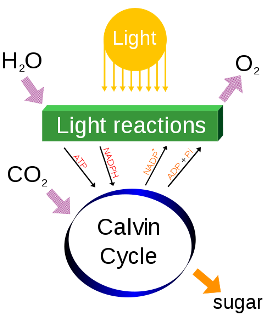
Nutrition
Like all of the blue-green algae Anabaena get their
nutrition through photosynthesis. Photosynthesis is the process
of creating energy from
 sunlight, and is grouped into two
different reactions, the aptly named "light-dependent" reactions
and the "light-independent" reactions.
sunlight, and is grouped into two
different reactions, the aptly named "light-dependent" reactions
and the "light-independent" reactions.
The light dependent reactions are the capturing of light energy from the sun and turning it into energy usable by cells. This usable energy is known as NADPH and ATP, which is also used by animals. This reaction is carried out in the thylakoid membrane. Also, it is performed in two routes. The first one generates the NADPH by sending an excited electron through and electron transport chain. The second route generates ATP through a proton gradient in the thylakoid membrane. Water splitting is the source of both the electrons and protons, and produces oxygen as a by product.
The light independent reactions, or Calvin cycle, involve the fixing
of
 atmospheric carbon dioxide into sugars the organism can use.
This reaction takes place in the cytoplasm. While these reactions
are called the light independent reactions, they actually happen at the
same time as the light dependent reactions, however light is not needed
for these reactions to occur. The light independent reactions use
the products of the light dependent reactions, NADPH and ATP, as the
fuel to create the sugars needed for energy by the cell.
atmospheric carbon dioxide into sugars the organism can use.
This reaction takes place in the cytoplasm. While these reactions
are called the light independent reactions, they actually happen at the
same time as the light dependent reactions, however light is not needed
for these reactions to occur. The light independent reactions use
the products of the light dependent reactions, NADPH and ATP, as the
fuel to create the sugars needed for energy by the cell.
To learn more about photosynthesis and how all plants get their energy have a look at this site!
Anabaena also requires other compounds to survive, however it has developed many adaptations regarding these compounds. If you haven't seen these adaptations do so now!
Now that you know how Anabaena acquires its energy, lets look at how they grow and reproduce, or head back home.